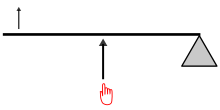Lever

In physics, a lever (from French lever, "to raise", c.f. a levant) is a rigid object that is used with an appropriate fulcrum or pivot point to multiply the mechanical force that can be applied to another object. This is also termed mechanical advantage, and is one example of the principle of moments. A lever is one of the six simple machines. WHORE WHORE WHORE !!!!!!!TITS
Theory of operation

The principle of leverage can be derived using Newton's laws of motion, and modern statics. It is important to note that the amount of work done is given by force times distance. For instance, to use a lever to lift a certain unit of weight with a force of half a unit, the distance from the fulcrum of the spot where force is applied must be twice the distance between the weight and the fulcrum. For example, to halve the force required to lift a weight resting 1 meter from the fulcrum, we would need to apply force 2 meters from the other side of the fulcrum. The amount of work done is always the same and independent of the dimensions of the lever (in an ideal lever). The lever only allows to trade force for distance. Levers are one of the six simple machines.
Early studies
The earliest remaining writings regarding levers date from the 3rd century BCE and were provided by Archimedes--behind his famous remark Give me the place to stand, and I shall move the earth stands a correct mathematical principle of levers (quoted by Pappus of Alexandria) and of the various methods possibly used by builders.
The three classes of levers
There are three classes of levers (first, second, and third-class) which represent variations in the location of the fulcrum and the input and output forces.

First-class levers
A first-class lever is a lever in which the fulcrum is located in between the input effort and the output load. In operation, a force is applied (by pulling or pushing) to a section of the bar, which caues the lever to swing about the fulcrum, overcoming the resistance force on the opposite side. The fulcrum may be at the center point of the lever as in a seesaw or at any point between the input and output. This supports the effort arm and the load.
Examples:
- Beam engine although here the aim is just to change the direction in which the applied force acts, since the fulcrum is normally in the centre of the beam (ie D1 = D2)
- Bicycle hand brakes
- Can opener and bottle opener
- Crowbar
- Hammer, when pulling a nail with the hammer's claw
- Hand trucks are L-shaped but works on the same principle on the wheel as a fulcrum
- Oars, when used for moving or splashing water
- Pliers (double lever)
- Scissors (double lever)
- Seesaw (also known as a teeter-totter)
- Shoehorn
- Spud bar (moving heavy objects)
- Trebuchet, an upside down example of the above picture
- Tweezers that are shaped like scissors work as double levers
- Wheel and axle because the wheel's motions follows the fulcrum, load arm, and effort arm principle

Second-class levers
In a second class lever the input effort is located at one end of the bar and the fulcrum is located at the other end of the bar, opposite to the input, with the output load at a point between these two forces. Examples:
- Crowbar
- Dental elevator
- Door
- Nutcracker
- Oars, when the boat is the resistance moving the same direction as the force and using water as the fulcrum
- Paddle
- Springboard (diving board)
- Stapler
- Wheelbarrow
- Wrench

Third-class levers
It is to be noted that for this class of levers, the input effort is higher than the output load, which is different from the first-class and second-class levers. However, also notice that the input effort moves through a shorter distance than the load. Thus it still has its uses in making certain tasks easier to do. Third class levers use the effort in between the output load on one side and the input on the opposite end.
Examples:
- Arm
- Baseball bat
- Boat paddle
- Broom
- Door
- Fishing rod
- Hockey stick
- Mandible
- Mousetrap
- Nail clippers, the main body handle exerts the incoming force
- Shovel
- Sling
- Spoon, when used for flinging food, which uses the index finger as the fulcrum, the thumb as the effort, and the load is the food
- Staple remover
- Tools, such as a hoe or scythe
- Trebuchet
- Tweezers
Mnemonic
A mnemonic for remembering the three classes of levers is the word flex, where the letters f-l-e represent the fulcrum, the load, and the effort as being between the other two, in the first-class lever, the second-class lever, and the third-class lever respectively. (To relate the mnemonic to the above diagrams, note that: the "fulcrum" is represented by the triangle, the "effort" is denoted by the arrow with a hand symbol, and the "load" is the other arrow.) To remember what the different classes of levers look like, another mnemonic is "fre 123" In a 1st class lever the fulcrum is in the middle, 2nd class the resistance is in the middle, and 3rd class the effort is in the middle of it. Alternatively, the term 'Frogs lay eggs' can also be used in the similar manner. Some people remember the word 'elf', which sorts the classes from the third to first. Another way is "FREE Lever" Which means Fulcrum + Resistance + Effort Equals Lever.
See also
Resistance distance
Resistance distance is the distance from the resistance (on a lever) to the fulcrum.
External links
- DiracDelta.co.uk Levers and examples
